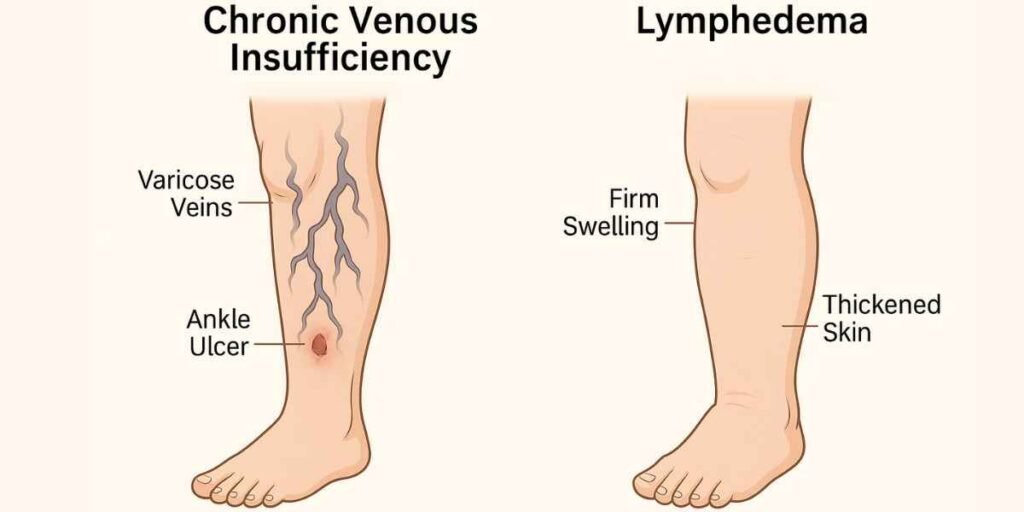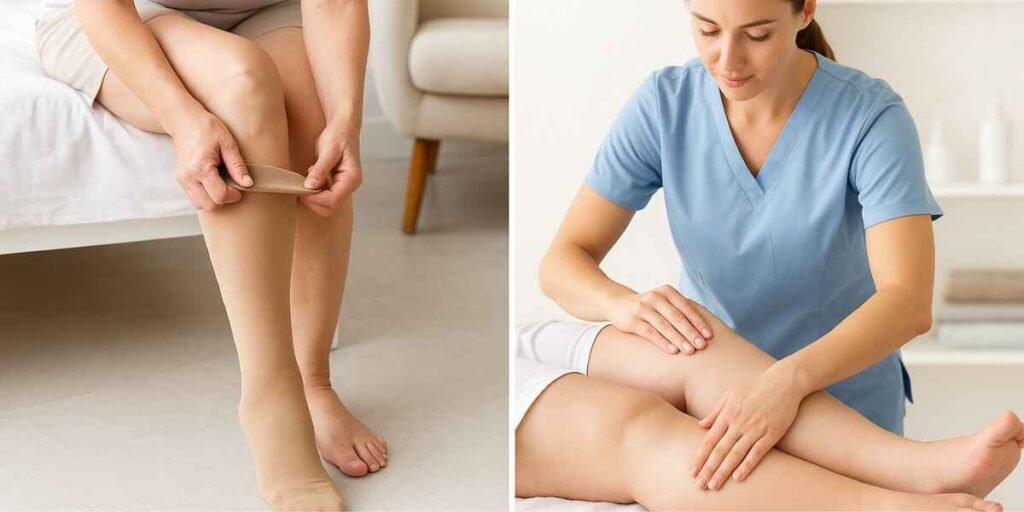Understanding Chronic Venous Insufficiency vs Lymphedema
Chronic venous insufficiency vs lymphedema are two distinct conditions that affect the circulation of fluids in the body. Both involve swelling and discomfort but they stem from very different causes. Chronic venous insufficiency occurs when veins in the legs fail to return blood properly to the heart. Lymphedema on the other hand results from a buildup of lymphatic fluid due to a damaged or blocked lymphatic system. Since the symptoms can be quite similar, many people mistakenly believe the two conditions are the same. Understanding chronic venous insufficiency vs lymphedema is essential for proper diagnosis, effective treatment and long-term management.
What Is Chronic Venous Insufficiency?
Chronic venous insufficiency (CVI) is a condition where the veins in the legs have trouble sending blood back to the heart. Normally valves inside veins act like one-way doors keeping blood flowing upward. But when these valves become weak or damaged blood begins to pool in the lower legs.
Over time this leads to leg swelling, skin changes and sometimes ulcers near the ankles. CVI usually develops slowly. Risk factors include aging, obesity, pregnancy, long periods of standing or a history of deep vein thrombosis (DVT). An early symptom is a sense of fatigue or heaviness in the legs, especially after standing for long periods.
What Is Lymphedema?
Lymphedema is caused by a blockage or malfunction in the lymphatic system. Instead of blood this condition involves lymph fluid a clear fluid that helps remove waste and fight infection. When lymph flow is disrupted fluid builds up in tissues and causes swelling.
Lymphedema may develop after cancer treatments, infections, or surgeries that damage lymph nodes. It can also be inherited. Unlike CVI, lymphedema may affect the arms or legs and often results in firm non-pitting swelling that doesn’t reduce with elevation. Though both involve swelling chronic venous insufficiency vs lymphedema differ in origin, feel and treatment.
Read more Interesting articles
Key Causes Behind Chronic Venous Insufficiency vs Lymphedema
While both chronic venous insufficiency and lymphedema lead to fluid buildup in the body their root causes are completely different. Understanding what triggers these conditions is the first step toward managing them effectively. Some causes are preventable while others are linked to genetics or past medical events. Let’s explore what leads to each.
Common Causes of Chronic Venous Insufficiency
Chronic venous insufficiency often develops due to weakened or impaired vein walls and malfunctioning valves. When these valves stop working properly blood begins to flow backward and pool in the legs. Over time this increases pressure in the veins and causes swelling.
One major cause is deep vein thrombosis (DVT) where blood clots form in deep veins and damage the valves. Other contributing factors include prolonged standing or sitting, obesity, pregnancy and aging. Jobs that require people to stand for long hours like nurses or retail workers can raise the risk significantly.
In rare cases a related condition known as chronic cerebrospinal venous insufficiency has been studied where impaired blood drainage from the brain and spine might contribute to neurological symptoms. Although still under investigation it highlights the importance of healthy venous circulation beyond just the legs.
Common Causes of Lymphedema
Lymphedema develops when the lymphatic system is unable to drain lymph fluid properly. This can happen due to damage, blockage or malformation of lymph vessels or nodes. The most common cause is cancer treatment especially surgeries or radiation that affect lymph nodes.
Infections, trauma and even certain parasitic diseases in tropical regions can also trigger lymphedema. Some people are born with underdeveloped or missing lymphatic vessels which leads to primary lymphedema.
Although they both involve fluid retention the causes behind chronic venous insufficiency vs lymphedema highlight how different systems of the body can produce similar symptoms.
Signs and Symptoms: Chronic Venous Insufficiency vs Lymphedema
Although chronic venous insufficiency and lymphedema may look similar at first glance their symptoms have unique patterns. Recognizing these signs early can help with faster diagnosis and better treatment. Each condition progresses differently and the discomfort it causes also varies.
Symptoms of Chronic Venous Insufficiency
The signs of chronic venous insufficiency usually begin gradually. People often feel heaviness or aching in their legs after standing for long periods. Swelling typically starts near the ankles and improves with leg elevation.
Skin may appear thin, dry or discolored often turning brownish over time. Small veins become more visible and itching or burning sensations may occur. In severe cases open sores or ulcers form especially around the ankles. A common sign of chronic venous insufficiency is the appearance of varicose veins which are enlarged and twisted beneath the skin.
Symptoms of Lymphedema
Lymphedema symptoms usually start with a mild, painless swelling in one limb. Over time the swelling becomes more pronounced and harder in texture. Unlike venous swelling, it doesn’t go away with elevation.
The skin may feel tight, thickened or spongy. In later stages movement in the affected limb can become limited. Lymphedema often comes with a risk of infections like cellulitis due to trapped fluid under the skin. The swelling can affect not just the limbs but also the hands, feet or even the chest wall.

Diagnosing Chronic Venous Insufficiency vs Lymphedema
Diagnosing these conditions begins with a physical exam and medical history. For chronic venous insufficiency, doctors often use a duplex ultrasound. This test checks how blood flows through the veins and whether valves are working properly. In some cases venography a special X-ray with contrast dye may be done to get a detailed view of the veins.
Lymphedema diagnosis usually relies on clinical signs especially if there’s a history of surgery, infection or trauma. Imaging tests like lymphoscintigraphy can track how lymph fluid moves through the body. Other tools include MRI or CT scans to detect blockages or structural issues in the lymphatic system. Accurate diagnosis is crucial when comparing chronic venous insufficiency vs lymphedema as treatment plans differ significantly.
Treatment Approaches: Chronic Venous Insufficiency vs Lymphedema
Though both conditions involve swelling and discomfort their treatment methods target different systems in the body. Chronic venous insufficiency focuses on improving blood return to the heart while lymphedema management centers on draining excess lymph fluid. Early intervention can reduce complications and improve quality of life.
Managing Chronic Venous Insufficiency
The primary goal in treating chronic venous insufficiency is to restore healthy blood flow in the legs. One of the most common and effective tools used is chronic venous insufficiency compression stockings. These special garments apply consistent pressure to the lower legs helping push blood upward toward the heart.
In addition to wearing chronic venous insufficiency compression stockings, patients are encouraged to elevate their legs several times a day, stay physically active and avoid long periods of standing or sitting. In more advanced cases, medical procedures like vein ablation or sclerotherapy may be recommended to close or remove damaged veins.
Managing Lymphedema
Lymphedema treatment involves reducing fluid buildup and preventing infection. Manual lymphatic drainage (MLD) is a gentle, therapeutic massage method designed to guide lymph fluid through properly functioning lymph vessels. Compression bandages or garments are also essential to maintain pressure and prevent fluid from returning.
Exercise, skincare and avoiding injury to the affected area are key components of lymphedema care. In severe or unresponsive cases surgical options may be considered to remove excess tissue or create new lymphatic drainage routes.
Despite similar symptoms treating chronic venous insufficiency vs lymphedema requires separate strategies tailored to each condition’s cause.

Can Swimming Help? Chronic Venous Insufficiency vs Lymphedema
Swimming is often recommended as a low-impact exercise for people with circulation and lymphatic issues. The natural pressure from water acts like gentle compression which helps reduce swelling and improve blood and lymph flow. It’s especially beneficial for those who find land-based exercise difficult due to leg pain or heaviness.
Many experts agree that is swimming good for chronic venous insufficiency patients? Yes, it offers both movement and pressure without putting strain on the joints. The same is true for lymphedema. Water’s resistance improves muscle tone while encouraging fluid movement. If you’re wondering is swimming good for chronic venous insufficiency and lymphedema the answer is a strong yes but always consult a doctor before starting.
Chronic Venous Insufficiency vs Lymphedema: Risk Factors and Prevention
Understanding what increases the risk of chronic venous insufficiency and lymphedema can help individuals take early preventive steps. While some factors like genetics or past medical treatments can’t be avoided, lifestyle changes can significantly lower the chances of developing either condition.
Risk Factors to Watch Out For
Several health and lifestyle elements can raise your chances of developing these conditions. For chronic venous insufficiency risk factors include age obesity, pregnancy, prolonged sitting or standing and a history of deep vein thrombosis. People with jobs that limit leg movement or involve long hours on their feet are especially vulnerable. Early chronic venous insufficiency symptoms like leg heaviness or skin discoloration should not be ignored.
Lymphedema on the other hand is more likely after lymph node removal, radiation therapy or trauma to the lymphatic system. Infections such as cellulitis or parasitic diseases can also trigger lymphatic damage, especially in tropical regions. Some people inherit weak or missing lymph vessels leading to primary lymphedema from a young age.
How to Reduce the Risk of Both Conditions
Prevention begins with daily habits. Regular exercise and leg elevation can reduce pressure in the veins. Wearing compression stockings may help if you’re prone to swelling or work on your feet all day. For those recovering from cancer treatments monitoring limb size and skin changes is key.
Recognizing chronic venous insufficiency symptoms early and understanding the shared risks in chronic venous insufficiency vs lymphedema allows for more proactive care.
Comparison Table: Chronic Venous Insufficiency vs Lymphedema
Although chronic venous insufficiency and lymphedema share a few outward symptoms such as swelling they stem from very different origins and respond differently to treatment. Understanding these differences can guide patients and caregivers toward more accurate diagnosis and care. The table below highlights the key features of chronic venous insufficiency vs lymphedema in a side-by-side comparison.
| Feature | Chronic Venous Insufficiency | Lymphedema |
| Definition | Poor return of blood from legs to the heart due to faulty vein valves. | Build-up of lymphatic fluid due to a damaged or blocked lymph system. |
| Primary Cause | Damaged vein valves, often from DVT or prolonged standing. | Lymphatic system damage from surgery, infection, or genetics. |
| Common Symptoms | Leg heaviness, swelling, skin discoloration, varicose veins. | Firm, non-pitting swelling, thickened skin, reduced limb mobility. |
| Affected Areas | Mainly lower legs and ankles. | Arms, legs, feet, or even chest depending on lymph disruption. |
| Diagnostic Tools | Duplex ultrasound, venography. | Lymphoscintigraphy, MRI, physical evaluation. |
| Treatment Options | Compression stockings, leg elevation, vein ablation, lifestyle changes. | Manual drainage, compression bandaging, skincare, light exercise. |
| Response to Compression | Often very effective in reducing swelling and symptoms. | Helpful but requires specialized bandaging techniques. |
| Exercise Benefits | Walking, swimming improve circulation and reduce symptoms. | Gentle movement like swimming aids lymph flow and reduces buildup. |
This clear overview of chronic venous insufficiency vs lymphedema helps distinguish their features and supports more targeted treatment strategies.
Conclusion: Managing Chronic Venous Insufficiency vs Lymphedema Long-Term
Long-term management of chronic venous insufficiency vs lymphedema depends on accurate diagnosis and tailored care. While both conditions involve swelling their causes and responses to treatment differ greatly. CVI is linked to damaged vein valves and benefits from early use of chronic venous insufficiency compression stockings, while lymphedema results from lymphatic blockages that require manual drainage and lifelong monitoring.
Emerging research into chronic cerebrospinal venous insufficiency suggests a broader impact of vein dysfunction beyond the legs, further emphasizing the need for early evaluation. Similarly, questions like is swimming good for chronic venous insufficiency highlight the growing awareness of gentle supportive exercises in managing symptoms. Though the two conditions are often confused understanding their differences allows for better outcomes and a higher quality of life. Continued studies on chronic cerebrospinal venous insufficiency may even reshape how venous disorders are viewed in the future.
Frequently Asked Questions about Chronic Venous Insufficiency vs Lymphedema
1. Can chronic venous insufficiency vs lymphedema occur together?
Yes, it’s possible to have both conditions at the same time especially in people with poor circulation and a history of surgery or radiation. This is called phlebolymphedema and it requires a combination of therapies to manage both venous and lymphatic problems.
2. What are the early signs of chronic venous insufficiency?
Early signs of chronic venous insufficiency include leg heaviness, mild swelling and aching after standing. Skin discoloration or the appearance of varicose veins may follow. These symptoms often get better with rest or leg elevation.
3. Is swimming good for chronic venous insufficiency vs lymphedema?
Absolutely Yes. Many experts agree that is swimming good for chronic venous insufficiency and lymphedema management. Water provides gentle pressure and supports movement, helping improve circulation and lymph flow without straining the joints.






